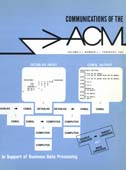February 1966 - Vol. 9 No. 2

Features
In this paper a description is given of a model programming system which is directed by a programming language and has a library for storing the user's items. Rules are given for transforming programs written in the language and for rearranging the items in the library so that they share their common parts. Some speculations are made about how the mechanical detection of common parts or patterns of library items could help a user to solve his problems, and about the relationships between the behavior of the reprogramming machine and human intelligent behavior.
The structure of programming languages
In this paper the major components of every programming language are identified as: (1) the elementary program statement, (2) mechanisms for linking elementary statements together, (3) the means by which a program can obtain data inputs. Several alternative forms of each of these components are also described, compared and evaluated. Many examples, frequently from list processing languages, illustrate the forms described.
The advantages, disadvantages and factors influencing the choice of a form of component for a language are discussed, and the paper concludes with the suggestion that programming languages evolve toward one which will permit all the most convenient ways of structuring programs, organizing systems and referencing data.
A language for describing the functions of synchronous systems
Before the design of a system is started, the exact function desired of it should be specified. It is suggested that a computer-oriented language be used for this purpose. The inadequacies of the standard programming languages for the description of systems are discussed, and a dialect of ALGOL which is suitable for describing synchronous systems is introduced. These descriptions can be used for simulation and automatic design of the system described, in addition to communicating system specifications.
A comparison of the FORTRAN language implementation for several computers
A feature-by-feature comparison is made of five different implementations of FORTRAN IV representing three different manufacturers. A table is constructed showing, where possible, the use of each feature in each implementation. Only those items which are different from, or have been added to FORTRAN II are shown.
BUGSYS: a programming system for picture processing—not for debugging
BUGSYS is a picture processing and measuring system that depends upon a pictorial input to the computer's memory. BUGSYS can be used for many types of applications. In particular, the authors have used the system for the analysis of linear graphs. The main concept of the system is the use of a collection of programmable pointers, which are visualized as a family of “bugs.”
EULER: a generalization of ALGOL, and its formal definition: Part II
In this section the algorithmic language EULER is described first informally and then formally by its syntax and semantics. An attempt has been made to generalize and extend some of the concepts of ALGOL, thus creating a language which is simpler and yet more flexible than ALGOL 60. A second objective in developing this language was to show that a useful programming language which can be processed with reasonable efficiency can be defined in rigorous formality.
Control procedures for data communication—an ASA progress report
Sectional Committee X.3 of the American Standards Association, has charged one of its task groups, X3.3.4, with the responsibility to “Define and specify functional control requirements and characteristics governing the operation of digital data generating and receiving systems interconnected by communication system.” This effort is primarily directed toward systems employing the American Standard Code for Information Interchange (ASCII).
This paper represents a progress report on the work of this group toward a proposal for national and international standardization in the field of control procedures. It describes both the old and new work of the task group. The new work is presented in detail, while the work that has been presented in earlier papers [“Control Procedures for Data Communication,” Task Group document X3.3.4/44, May 1964: “Transparent-Mode Control Procedures for Data Communication,” Task Group document X3.3.4/58, December, 1964: Comm. ACM 8 (Apr. 1965), 203-206; “Control Procedures for Data Communication,” Task Group document X3.3.4/60, March, 1965] is retained here in summary form. Many of the concepts and principles described herein have been submitted to the International Organization for Standardization via earlier papers and are now embodied in working papers of that organization.
Many business applications employ sequential magnetic tape rather than random-access storage techniques to process a very small number of transactions against a voluminous master file. In such situations, it may prove economical to avoid creating a new master file during each updating run by producing instead a dribble ledger containing only those master file accounts which have experienced activity.
Tests of probabilistic models for propagation of roundoff errors
In any prolonged computation it is generally assumed that the accumulated effect of roundoff errors is in some sense statistical.
The purpose of this paper is to give precise descriptions of certain probabilistic models for roundoff error, and then to describe a series of experiments for testing the validity of these models.
It is concluded that the models are in general very good. Discrepancies are both rare and mild.
The test techniques can also be used to experiment with various types of special arithmetic.
The problem of the region of stability of the fourth order-Runge-Kutta method for the solution of systems of differential equations is studied. This region can be characterized by means of linear transformation but can not be given in a closed form. In the paper, this region is determined by the electronic digital computer Z22.
Description of a high capacity, fast turnaround university computing center
The operating system for the UNIVAC 1107 at Case Institute is reviewed. The system is of interest because of the low turn-around times achieved, the high throughput achieved and the lack of an operating staff. Turnaround times below 5 minutes and job volume above 75,000 per quarter year are reported.



